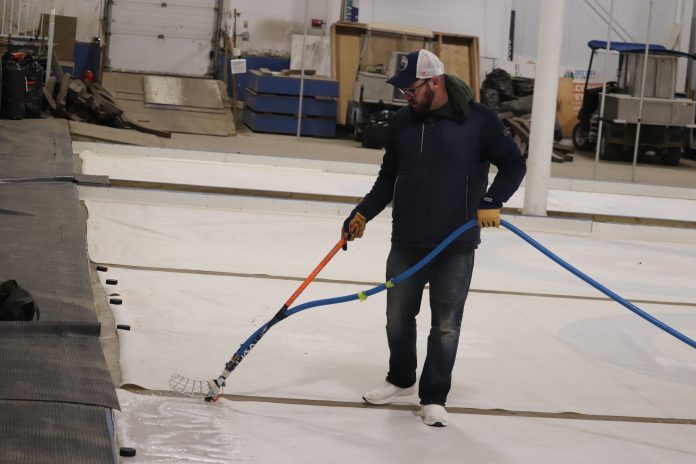
The ice plant has been fired up for the season and ice installation is underway at the Prince Albert Golf and Curling Club.
For Drew Ryhorchuk, that means the end of his time working in the pro shop at Cooke Municipal Golf Course and getting fully into his duties as the head ice technician, installing a fresh sheet of ice for the upcoming curling season.
Ryhorchuk says the early stages of the ice installation can be the most time-intensive part of the process.
“We hooked up the ice plant three days ago and waited for it to cool down. Since then, we got the boards in, the lines are down, and we got our base layer down last night. Today, we pulled out the white sheets, and that’s what you see out here now. On TV, you’ll see paint but we opt to go to the sheets where it is a lot easier for maintenance and clean-up. Now is the tough stuff, it’s flooding so it is a lot of man hours where it’s boring, don’t get me wrong, but the water has to get down just for the curlers to get out there.”
The early stages of making ice for hockey and curling are very similar, however curling requires a lot more of a specialized surface for the sport. Curling ice requires the process of pebbling.
Ryhorchuk says the process of pebbling reduces the amount of contact directly with the ice surface.
“With hockey ice and curling ice you both use a chemical called jet ice. That’s a chemical that goes into the water. You have your main water then it’s the chemical that fluids through then it goes to a hot water tank. With us here you flood through cold water which goes through that jet ice so it kind of bypasses that system. Curling ice itself is a pebbled ice so the curling rock, it only floats on just a little bit of a surface rather than a hockey puck where it’s the full surface where guys can skate on. It is minimal contact and it uses the surface area to move down the ice including curler’s shoes where they use Teflon or a steel slider to get down the ice.”
Pebbling doesn’t include putting literal rocks in the ice, but the process of the icemaker sprinkling small droplets of water over the ice surface that harden and freeze within a few seconds. The purpose of pebbling is to reduce the friction between the rock and ice, which allows the rock to slide.
Ryhorchuk is still very early in the process of creating the ice and he is hopeful that curlers will be on the surface later this month.
“Hopefully, knock on wood. We’re ready for Oct. 15. That’s 12 days away from now, so it is a bit of a grind. That’s why we are putting out a heavy flood today to get that coverage to jump one step so we don’t have to do it again tonight. You get usually between eight to 12 floods down and then you kind of start to have level ice out there. Monday, so three days from now, you’ll see rings out here, you’ll see string and foam and that’s when it looks like a curling rink and you know you are close.”
“This is the early stages so this is all the behind-the-scenes. You move the boards, the rocks and the flooding. Getting closer to the season you get to scrape and pebble and that’s the fun stuff. That’s where you see the guys in between the draws on TV going out there and doing what they can. That’s where the magic works so that’s coming soon. We’re excited, we can’t wait but soon it’ll be out there and we’re hoping that we get more curlers out here this year than we did last year.”
More information about curling leagues for the upcoming season can be found at pagcc.ca
sports@paherald.sk.ca

